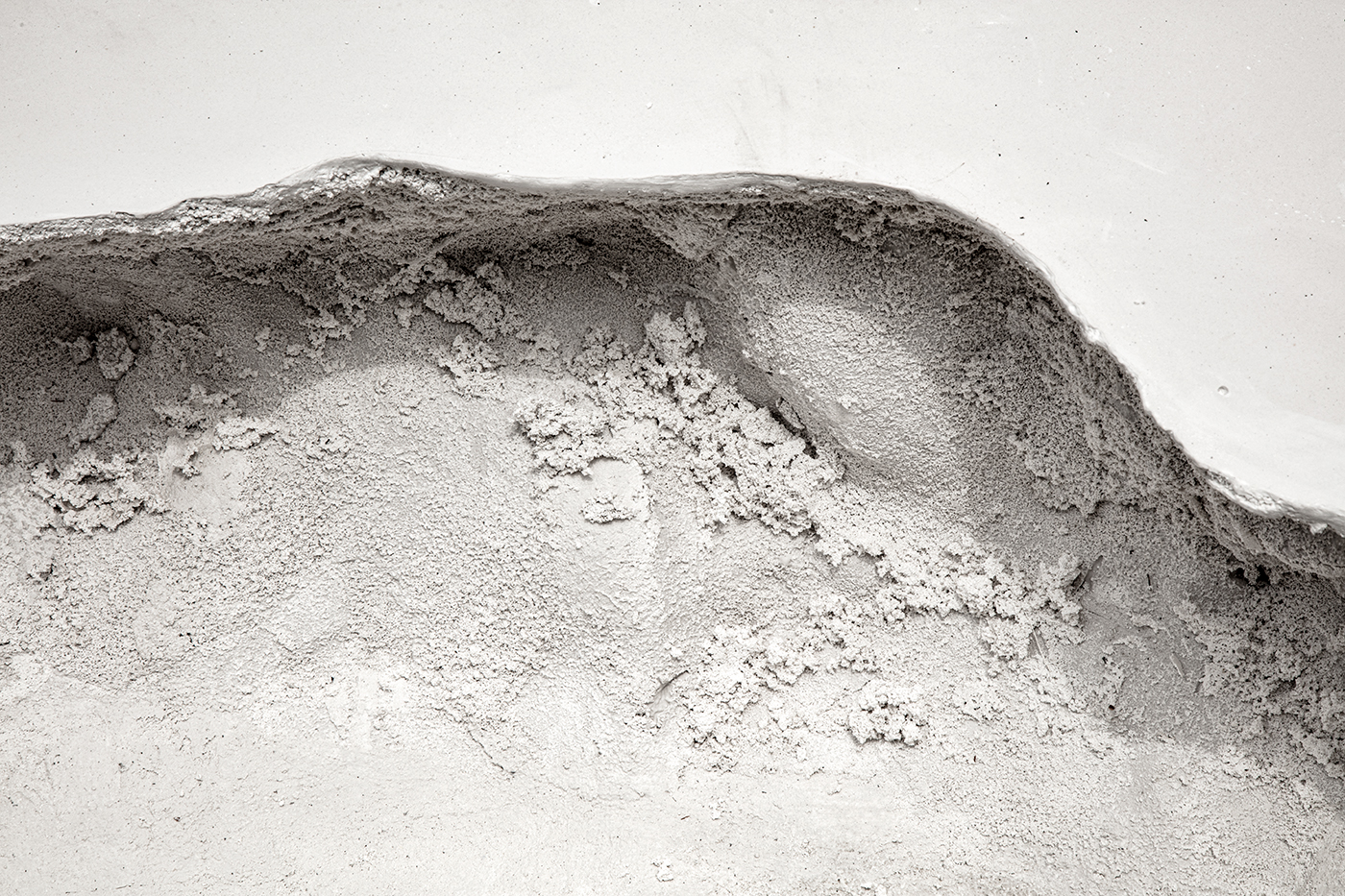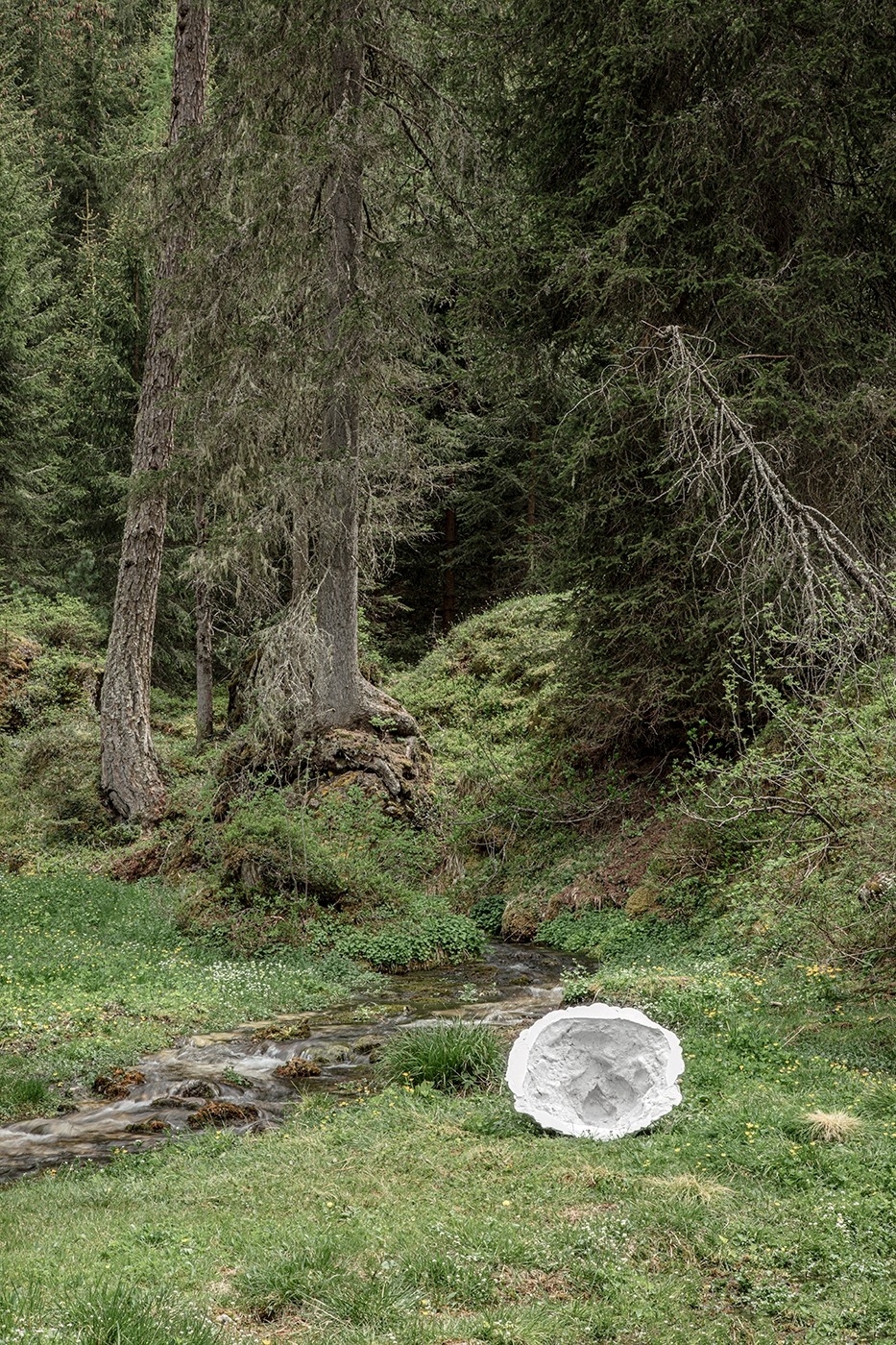ELISABETH EITER, “DEM FERNER NÄHER”.
Linz, Austria.
Location Pares, Lungiarü.
Elisabeth Eiter's intervention is site-specific in a twofold sense: it is designed for this place and is carried out on site. The artist took some blocks of snow from the surrounding area, took them to Pares and placed them on shelves to cover them with plaster. The encounter of discrepant elements causes a reversal of the respective characteristics. The viscous plaster hardens and releases heat, which in turn melts the ice, thus revealing the shape of its negative. How can one accept or take the diminution and attenuation of something? This is one of the reflections that the artist would like to propose, indicating as a possible solution the proactive surprise of the emergence of something new.
The title also contains a play on words: "Ferner" has two meanings - on the one hand it's the surface snow layer of a glacier that compacts over time and becomes ice, on the other hand it is the comparison of the adjective "far", so "farther"; "näher" is "closer". The semantic game wants to suggest that the Heimat is a return to a closeness (geographical, but especially emotional). The closeness to something that is felt to be original is in turn, according to the artist, the bearer of contentment - Heimat is therefore the nostalgia for an ancestral state of happiness.
〉 Ladin
L’intervënt de Elisabeth Eiter é site-specific te dui significac: al é gnü ponsé por chësc post y al é gnü fat söl post. L’artista á tut n valgügn blocs de nëi tles vijinanzes, i i á portá sön Pares y i i á metüs sön pontins por i corí de ghips. L’incuntada di elemënc contrastanc gaujëia na inverjiun dles carateristiches de vignun. Le ghips toch devënta dür menan fora cialt che fej dlighé la dlacia y insciö vëgnel a löm la sagoma dl negatif. Co pón pa azeté o capí le jí zoruch, le gní demanco de na cossa? Chësta é öna dles reflesciuns che l’artista oress porté dant, indican sciöche resposta poscibla che adinfora vëgnel a s’al dé valch de nü.
Le titul contëgn n jüch de parores: „Ferner“ á dui significac – da öna na pert él la parora todëscia por le strat de nëi superfizial de n dlaciá che cun le tëmp vëgn compat y devënta dlacia; dal’atra él le comparatif dl agetif „dalunc“, „plü dalunc“; „näher“ ó dí „plü dlungia“. Le jüch semantich nes dij che la Heimat é n jí zoruch a valch de daimpró (valch de geografich, mo dantadöt de emotif). Ti ester dlungia a valch che vëgn sintí sciöche originar porta aladô dl’artista contentëza – Heimat é insciö l’incherscimun do na condiziun de felizité che vá zoruch a nüsc antenac.
〉 Italiano
L’intervento di Elisabeth Eiter è site specific in un duplice senso: è pensato per questo luogo ed è realizzato sul posto. L’artista ha prelevato alcuni blocchi di neve nei dintorni, li ha portati a Pares e li ha posato su ripiani onde ricoprirli di gesso. L’incontro di elementi discrepanti provoca una inversione delle rispettive caratteristiche. Il gesso viscoso indurisce sprigionando calore, il quale a sua volta fa sciogliere il ghiaccio, rivelando così la sagoma del suo negativo. Come si può accettare o prendere la decrescenza e l'attenuarsi di una cosa? Questa è una delle riflessioni che l'artista vorrebbe proporre, indicando come possibile soluzione la propositiva sorpresa dell’affiorare di qualcosa di nuovo.
Inoltre il titolo contiene un gioco di parole: “Ferner” ha due significati – da una parte è lo strato di neve superficiale di un ghiacciaio che si compatta nel tempo e diventa ghiaccio, dall’altra è il comparativo dell’aggettivo “lontano”, quindi “più lontano”; “näher” è “più vicino”. Il gioco semantico vuole suggerire che la Heimat è un ritorno ad una vicinanza (geografica, ma soprattutto emotiva). La vicinanza a qualcosa che è sentito come originario è a sua volta, secondo l’artista, latrice di contentezza – Heimat è perciò la nostalgia di un ancestrale stato di felicità.
〉 Deutsch
Die Intervention von Elisabeth Eiter ist in doppelter Hinsicht ortsspezifisch: Sie ist für diesen besonderen Standort konzipiert und wird auch vor Ort aufgestellt. So nahm die Künstlerin mehrere Schneeblöcke aus der Umgebung, brachte sie nach Pares und stellte sie auf Bretter, um sie dann mit Gips zu verkleiden. Das Zusammentreffen dieser ungleichen Elemente führt zu einer Umkehrung ihrer jeweiligen Merkmale. Der zähflüssige Gips härtet aus und gibt Wärme ab, die wiederum das Eis schmelzen lässt und so die Form seines Negativs offenbart. Wie kann man das Schrumpfen und Schwächerwerden einer Sache hinnehmen oder damit umgehen? Dies ist eine der Überlegungen, die die Künstlerin uns nahelegt, indem sie als mögliche Lösung eine proaktive Überraschung der Entstehung von etwas Neuem unterbreitet.
Der Titel enthält zudem ein Wortspiel, denn "Ferner" hat zwei Bedeutungen - zum einen ist es die Oberflächenschneeschicht eines Gletschers, die sich im Laufe der Zeit verdichtet und zu einer Eismasse wird, zum anderen natürlich die Steigerung des Adjektivs "fern", also "weiter entfernt"; mit "näher" als Gegenteil. Das semantische Spiel will suggerieren, dass Heimat eine Rückkehr zu einer (geografischen, vor allem aber emotionalen) Nähe ist. Die Nähe zu etwas, das als originär empfunden wird, bringt nach Ansicht der Künstlerin Zufriedenheit mit sich. Heimat ist daher die Sehnsucht nach einem angestammten Glückszustand.
EXHIBIT SPACE
Ćialdires and Pares - The springs close to the Longiaru valley are one of those hidden and isolated places where human beings can feel the forces of nature. The water element, also important in myths and legends (the Ganes always lived close to a spring or lake), creates synergies that kindle the imagination and spirit of whosoever stops in those places.
〉 Ladin
Les Ćialdires y Pares, Lungiarü - Les fontanes tla val de Lungiarü é posć olache an sont na forza y energia particolara. Gonot tles vals ladines s’àl cherié liëndes y mîć incër rüsc y lêć ia. Chi che röia al dedaincö te chisc posć s’intënn ci belëza che al é inćer nos ia.
〉 Italiano
Les Ćialdires y Pares - Le sorgenti a ridosso della valle di Longiaru sono uno di quei luoghi nascosti e isolati dove l’uomo può esperire le forze emanate dalla natura. L’elemento dell’acqua, importante anche nei miti e nelle leggende (le Ganes vivevano sempre nei pressi di qualche sorgente o lago), crea sinergie per far involare la fantasia e lo spirito di colui che saprà sostare in questo luogo.
〉 Deutsch
Les Ćialdires und Pares - Die Quellen in der Nähe des Tals von Longiaru sind einer der versteckt und isoliert liegenden Orte, an denen der Mensch die von der Natur ausgehende Kraft erleben kann. Das Element des Wassers, bedeutsam auch in den Mythen und Legenden (die Ganes lebten stets in der Nähe einer Quelle oder eines Sees), erzeugt Synergien, die jedem die Phantasie und den Geist rauben, der an diesem Ort Rast macht.



